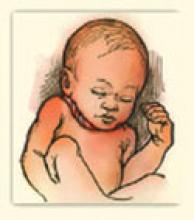User login
<court>Middlesex County (Mass) Superior Court</court>
A 30-year-old woman presented to the hospital in labor at full term. Labor was uneventful until 3:10 AM, when fetal heart tones allegedly suggested distress. The pattern continued, and moderate meconium was noted at 5:20 AM. At 6:00 AM, increased meconium was noted. The heart rate dropped to 80 bpm at 6:24 AM and to 60 bpm 5 minutes later.
An attempt was made to deliver the child by vacuum extraction; ultimately the infant was stillborn. Autopsy revealed normal anatomy and development with nuchal cord entanglement.
In suing, the woman claimed the defendant ignored signs of fetal distress and failed to initiate a cesarean section in a timely manner.
The defense contended that the decision to proceed vaginally was appropriate because the mother was nearly ready to deliver. The defense also claimed there was no sentinel hypoxic event before or during labor, and that the cord most likely tightened at the very end of labor.
- The parties reached a settlement of $525,000.
The cases in this column are selected by the editors of OBG Management from Medical Malpractice Verdicts, Settlements & Experts, with permission of the editor, Lewis Laska, of Nashville, Tenn (www.verdictslaska.com). While there are instances when the available information is incomplete, these cases represent the types of clinical situations that typically result in litigation.
<court>Middlesex County (Mass) Superior Court</court>
A 30-year-old woman presented to the hospital in labor at full term. Labor was uneventful until 3:10 AM, when fetal heart tones allegedly suggested distress. The pattern continued, and moderate meconium was noted at 5:20 AM. At 6:00 AM, increased meconium was noted. The heart rate dropped to 80 bpm at 6:24 AM and to 60 bpm 5 minutes later.
An attempt was made to deliver the child by vacuum extraction; ultimately the infant was stillborn. Autopsy revealed normal anatomy and development with nuchal cord entanglement.
In suing, the woman claimed the defendant ignored signs of fetal distress and failed to initiate a cesarean section in a timely manner.
The defense contended that the decision to proceed vaginally was appropriate because the mother was nearly ready to deliver. The defense also claimed there was no sentinel hypoxic event before or during labor, and that the cord most likely tightened at the very end of labor.
- The parties reached a settlement of $525,000.
The cases in this column are selected by the editors of OBG Management from Medical Malpractice Verdicts, Settlements & Experts, with permission of the editor, Lewis Laska, of Nashville, Tenn (www.verdictslaska.com). While there are instances when the available information is incomplete, these cases represent the types of clinical situations that typically result in litigation.
<court>Middlesex County (Mass) Superior Court</court>
A 30-year-old woman presented to the hospital in labor at full term. Labor was uneventful until 3:10 AM, when fetal heart tones allegedly suggested distress. The pattern continued, and moderate meconium was noted at 5:20 AM. At 6:00 AM, increased meconium was noted. The heart rate dropped to 80 bpm at 6:24 AM and to 60 bpm 5 minutes later.
An attempt was made to deliver the child by vacuum extraction; ultimately the infant was stillborn. Autopsy revealed normal anatomy and development with nuchal cord entanglement.
In suing, the woman claimed the defendant ignored signs of fetal distress and failed to initiate a cesarean section in a timely manner.
The defense contended that the decision to proceed vaginally was appropriate because the mother was nearly ready to deliver. The defense also claimed there was no sentinel hypoxic event before or during labor, and that the cord most likely tightened at the very end of labor.
- The parties reached a settlement of $525,000.
The cases in this column are selected by the editors of OBG Management from Medical Malpractice Verdicts, Settlements & Experts, with permission of the editor, Lewis Laska, of Nashville, Tenn (www.verdictslaska.com). While there are instances when the available information is incomplete, these cases represent the types of clinical situations that typically result in litigation.
